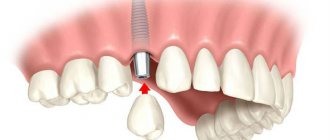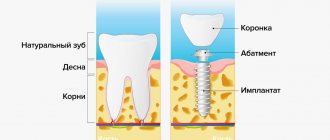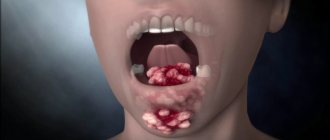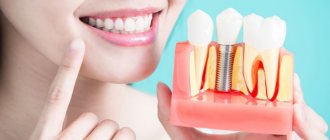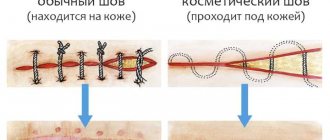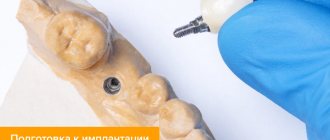Author: Brodsky Sergey Evgenievich Deputy Chief Physician, Candidate of Medical Sciences in the specialties: dentistry and medical microbiology The question of whether dental implants take root in everyone, that is, osseointegration takes place in a timely and effective manner, dentists hear very often. It is always asked by people preparing to restore teeth using artificial roots and crowns. Before deciding on this procedure, any person strives to find out all the possible risks. Dentists, when talking with their patients, always explain that it usually takes 2-6 months to complete the engraftment process of titanium roots, but many factors can influence its duration and if certain conditions are not met, the artificial root is quickly rejected.
Ask a question!
8
We'll call you back in 1 minute
How does implant healing occur?
After implantation, the bone tissue fuses with the implant, which ensures reliable attachment of the artificial root to the jaw bone. The process is called "osseointegration". Occurs in several stages:
- In the first month after implantation, trabeculae of spongy tissue form between the artificial root and the jaw bone tissue. The bone is soft, so the structure is not firmly attached and can be easily damaged if overloaded.
- By the fourth month, dense lamellar bone is formed and fills the free space. The implant is securely fixed, so it can already be loaded with crowns.
- After a year and a half, the structure completely fuses with the bone.
How long does it take for an implant to take root in the upper jaw?
Model of a titanium implant installed on the upper jaw
The procedure for implanting the upper and lower teeth is different. The upper dentition is more visualized when smiling, so it should have an extremely aesthetic appearance. Features of the anatomical structure of the jaw, in particular, the soft structure of the bone, require the use of elongated models of titanium rods. The proximity of the maxillary sinuses also complicates the specialist’s work.
Speaking about the timing of osseointegration, implants installed on the upper jaw take 3-6 months to take root , in the absence of complications. In the lower jaw, everything goes faster - within 2-4 months.
What determines the success of osseointegration
Several factors influence the success of engraftment:
- Proper preparation and planning.
- Patient's health status.
- Use of high-quality implants.
- Selecting an implantation method that is appropriate for the clinical situation.
- Correct calculation of the prosthesis design.
- Compliance with recommendations after implantation.
Attentive attention to each point ensures engraftment without complications.
Risks at the diagnostic and preparation stage
In order for engraftment to proceed without problems, it is important to eliminate risks at the stage of preparation for implantation:
- An examination is carried out for general somatic diseases to identify contraindications to surgery.
- The doctor diagnoses diseases of the oral cavity that are in the acute stage, paying close attention to the future site of implantation and surrounding tissues. The oral cavity is sanitized, adjacent teeth are treated, and plaque and stone are removed.
- An implant treatment plan is drawn up, and recommendations are given to the patient on the rules of preparation for the operation.
- 3D computer modeling helps to choose the shape and size of the implant. This is necessary so that the design fits the patient’s bone characteristics and does not reject it.
Patient's health status
Successful implantation is impossible in case of serious diseases that can cause implant rejection. The main contraindications for which implantation is strictly prohibited:
- malignant tumors;
- decompensated diabetes mellitus;
- blood clotting disorder;
- mental illness;
- tuberculosis;
- pathological diseases of the cardiovascular system;
- risk of heart attack or cardiac arrest;
- disruption of the immune system;
- thyroid diseases.
The patient should not hide his condition and agree to the procedure without prior diagnosis. In addition, diagnostics will help identify hidden diseases that you may not be aware of. Therefore, before the procedure, the doctor collects anamnesis and prescribes tomography, blood tests, and ECG for patients at risk.
Product requirements
All requirements for dental implants can be reduced to three postulates - functionality, comfort for the patient, convenience for the doctor.
Functionality requires the following properties:
- Good osseointegration , and even better - its potentiation, is achieved by the special properties of the material from which the implant is made, and a high level of its cleaning and sterilization.
- Ensuring stability (stability in the hole or hole) and rapid healing.
- Biocompatibility with tissues (low level of allergenicity).
- Long-term preservation of operational properties (ability to withstand chewing loads for a long time, strength, lack of corrosion).
- Providing opportunities for prosthetics.
Titanium, which is the main material in the manufacture of implants, fully meets all these requirements.
Convenience for the dentist is ensured by the following factors:
- A diverse range of products allows you to choose the most suitable design for a specific clinical situation. In particular, with cancellous porous bones, a cone-shaped shaft with self-tapping “aggressive” threads provides higher stability than cylindrical implants with fine threads.
- Logical technology for preparing the bone bed.
- The necessary set of screwdrivers and cutters to ensure quick and convenient installation of the implant.
All diagnostic equipment is located in the clinic - you don’t need to go anywhere
In our Center, during the period of implantological treatment, correction of chronic diseases is carried out, consultations are carried out by a full-time anesthesiologist and an ENT doctor. All diagnostic equipment is located in the clinic, you do not need to go anywhere. Blood tests can also be taken without leaving the clinic; the results will be ready within a day.
Levin Dmitry Valerievich
Chief physician, Ph.D.
Selecting an implant system
The service life of an implant depends on the thoughtful choice of its type and shape in accordance with the bone tissue. Healing is influenced by design characteristics, including material, coating, thread, and connection to the abutment. Accurate placement of the implant at the correct angle is important. All this depends on the qualifications of the doctor.
Our Center uses exclusively Nobel Biocare root-shaped structures, which are guaranteed for life. The survival rate of Nobel implants is 99.3% . The company managed to achieve this through a special porous Ti-Unite coating, which replicates the chemical composition of a natural tooth root. The bone tissue does not perceive the implant as a foreign body and begins to fuse with it, ensuring reliable engraftment for life.
In the case of Nobel Biocare implants with Ti-Unite coating, which we use at the Center, successful engraftment can be judged within a few days after the operation.
Nobel Biocare implants with Ti-Unite coating
Implant installation methods
When installing implants, one- and two-stage methods are used, which affect the healing period. The doctor himself chooses which option is best suited in the clinical situation.
- Classical implantation (two-stage method) . First, only an artificial root is installed in the jaw, and the gum above it is sutured. After osseointegration of the implant with the bone, a crown is fixed to it. Osseointegration takes an average of two months, but depends on the characteristics of the patient.
- Implantation with immediate loading (one-stage method) . The crown is fixed onto the implant immediately after installing the titanium root. The implant takes root with light loads, which stimulates the formation of bone tissue around the implant, thus reducing the osseointegration time. But this protocol is indicated only if there is sufficient volume and quality of jaw bone tissue.
- Single-stage implantation . The implant is installed immediately after tooth extraction into the root socket. The blood clot turns into bone, which envelops the root already at the stage of its formation. This accelerates the process of osseointegration. But this method is possible if there are no inflammatory processes at the root of the tooth, and the bone corresponds to the parameters in terms of density and size.
Whatever method is chosen, it is important to maintain sterility during the procedure so as not to infect the implant bed.
Prosthetics is an important component of implantation
After the implant has healed, an abutment is put on it, and the crown is fixed on top with cement. It is possible for cement to penetrate under the gum, and if it is not cleaned out, the implant will fail. We have moved away from this outdated technology for fixing crowns, reducing the likelihood of implant failure. We fix metal-free zirconium dioxide crowns not with cement, but with a solid screw connection.
The hidden screw connection between the implant and the crown is the gold standard for completing implant treatment.
Compliance with recommendations and oral hygiene
The International Implant Foundation states that the cause of implant failure is poor hygiene and non-compliance with recommendations. Requirements that speed up survival and reduce the risk of complications:
- minimal trauma to the surgical area;
- brush your teeth with caution for the first three days;
- Do not eat too solid food for two weeks;
- do not stop taking prescribed medications;
- avoid hypothermia or overheating of the body;
- do not smoke or drink alcohol;
- do not hide alarming symptoms during the rehabilitation stage.
Make an appointment with an implantologist
Dental implantation: care of the installed structure
In order for the implant to last as long as possible, you must strictly adhere to all doctor’s recommendations.
First, you need to choose a medium-hard brush instead of a hard one; You need to brush it in the same way as regular teeth: morning and evening, carefully removing food debris with special devices. Secondly, for the first time after installation, you need to exclude solid foods from your diet, massage your gums from time to time, and use medications prescribed by your dentist. If you follow all the recommendations, dental implantation will have a positive outcome. Both doctors and patients highlight the following advantages of dental implantation: the patient’s comfort is not affected after the installation of the structure; healthy teeth are not damaged; the design has a long service life (10 years or more).
How to find out whether an implant has taken root or not
If the body rejects the implant, this can be noticed in the first days after installation. The following are considered the norm:
- bleeding for no longer than 2 days;
- swelling that goes away after 5 days;
- pain syndrome does not last longer than one week;
- elevated temperature that goes away after 3 days.
Rejection symptoms:
- persistent bleeding;
- discharge of purulent masses;
- swelling of the gums and cheeks for more than a week;
- severe pain syndrome;
- temperature above 38 degrees throughout the week;
- headache;
- discharge from the sinuses;
- pain when pressing on the lower eyelid;
- air bubbles around the implant.
If you experience any warning symptoms, consult your doctor immediately.
Rejection can occur at different stages of osseointegration and even after several years of use:
- Early rejection - from 2-3 days to 2-3 months after implantation. The reason is the doctor’s mistakes during installation, when the design of the implant is incorrectly selected without taking into account the density of the bone tissue. Also, the implant may not take root due to the patient’s failure to comply with hygiene recommendations, smoking, or premature load on the implantation area.
- Delayed rejection - when a crown has already been installed on the implant. The reason is the incorrect calculation of the chewing load by the orthopedist. On the part of the patient - poor hygiene, smoking. Smokers have a 30% increased risk of rejection compared to non-smokers.
After implantation, it is important to provide conditions for implant healing. You need to carefully maintain oral hygiene. Monitor closely for symptoms. Visit your doctor according to your schedule. As a rule - twice a week. Do not neglect recommendations, no matter how inconvenient they may seem to you.
Reasons for rejection
The question of why the installed implant did not take root cannot be answered unambiguously, since there are a number of factors that can interfere with this process. These include:
- low quality of the implant (in order for artificial teeth to take root with a higher probability, you need to choose products from trusted brands);
- non-compliance with doctor's recommendations and oral hygiene;
- poor quality work performed by the dentist;
- high load on the artificial tooth;
- allergic reaction to materials included in the implant.
Also, the implant may not take root in case of immune diseases, when it is impossible to predict the result of implantation.
How to speed up the healing time of implants
Osseointegration is a physiological process, the speed depends on the condition of the patient’s bone tissue, the implantation method, and compliance with recommendations. But to protect yourself from unwanted rejection, you need to take care of this in advance:
- choose a clinic carefully - you should contact trusted institutions based on recommendations from friends after carefully studying the site and available information;
- contact a qualified doctor - you cannot go to a private specialist who does not officially work in the clinic, you should ask him for certificates, look at photos of examples of work;
- do not refuse preliminary preparation and diagnosis - a qualified doctor will insist on this stage;
- choose high-quality implants - preference for companies that have been presenting products on the market for at least 10 years;
- find out the warranty period and service - the nuances should be clarified before the procedure;
- check compliance with sterility and safety - clinics with a good reputation should work according to the Anti-AIDS-Anti-Hepatitis program.
Reviews
Implantation is a relatively expensive operation and has not yet become widespread in Russia.
But there is great interest in it from patients, since it allows you to solve almost any problem of the dentofacial apparatus.
If you have undergone dental implantation, share your experience with those who would like to, but for various reasons have not yet decided to undergo this operation. Leave a comment at the bottom of the page.
If you find an error, please select a piece of text and press Ctrl+Enter.
Question answer
Does smoking affect the healing of dental implants?
Yes, it does. Smokers are more likely to experience rejection in the medium to long term. Tobacco smoke reduces the activity of blood circulation, prevents the full supply of oxygen to tissues and the healing of wounds.
I am 62 years old. How long will the implant take to take root?
There are no strict age restrictions for implantation. But the survival period is determined by the condition of the bone tissue and the patient’s health. With age, osseointegration lasts longer, as bone tissue becomes more friable, immunity decreases, and systemic diseases appear.
Contraindications for surgery
Implantation is, although relatively simple, but still an operation accompanied by an aggressive invasion of tissue. Therefore, it is natural that it has contraindications.
Some of them are absolute, completely excluding the operation. Others are relative, requiring caution or elimination of pathology before implantation.
Relative contraindications include the following:
- Dental and periodontal diseases – caries, gingivitis, periodontitis, etc.
- Pregnancy and lactation.
- Vitamin deficiencies.
- Malocclusion.
- Pathological abrasion of teeth.
- Pathology of the ANS (temporomandibular joint).
- Exhaustion due to irregular or unhealthy diet.
- Engaging in dangerous sports.
- Malformations of the dentofacial apparatus - close proximity of the maxillary sinuses, bone atrophy, impacted teeth, arthrosis, arthritis.
- Bruxism.
Some of these factors can be ignored by the patient, others are eliminated as a result of treatment. In any case, the patient must be aware of the risks involved in order to be able to make an informed decision.
Important. Smoking is a relative contraindication for dental implantation. It does not interfere with primary osseointegration, however, it creates a high risk of peri-implant infections and complications.
Nicotine slows down wound healing, promotes crestal bone loss, and potentiates other factors that prevent implantation. Therefore, doctors strongly recommend that you completely stop smoking before surgery and for some time after it.
In addition to relative ones, there are absolute contraindications that cannot be ignored. A patient with them will be denied implantation:
- Chronic systemic diseases : tuberculosis, scleroderma.
- Pathologies of the endocrine system : diseases of the pituitary and adrenal glands, hypo- and hyperthyroidism.
- Low immunity , manifested by a number of diseases (polymyositis, thymic hypoplasia, lupus erythematosus, various infections, pathology of the parathyroid gland).
- Hematopoietic disorders (thalassemia, anemia, leukemia, lymphogranulomatosis).
- Impaired bone regeneration (osteonecrosis, osteoporosis, osteopathy, dysplasia).
- Diseases of the nervous system with impaired patient perception of information and the inability to comply with the requirements and recommendations of the doctor (dementia, psychosis, schizophrenia, drug addiction, alcoholism, paranoia, neuroses).
- Pathologies of connective tissue , especially manifested in the maxillofacial area (lupus erythematosus, rheumatic and rheumatoid diseases, scleroderma).
- Malignant tumors - especially during chemotherapy and radiotherapy, or some time after them.
- AIDS.
- Certain cardiovascular diseases (presence of an artificial heart valve, recent stroke or heart attack).
- Taking bisphosphonates - drugs that slow down bone resorption (antiresorptive therapy).
- Immunosuppressive therapy (for transplantations or treatment of systemic pathologies).
- Osteoradionecrosis as a result of radiation therapy.
- Intolerance to metals in the body.
What do the manufacturers and the clinic guarantee?
When working with implants, there are two types of warranty obligations:
- The manufacturer's warranty averages 20-25 years. Some companies provide lifetime benefits. In case of rejection of the structure, replacement is made provided that there is no fault of the specialist who performed the installation or the patient.
- The clinic's warranty is 1-2 years and applies only to work performed. The titanium rod is replaced free of charge only if it is established that the doctor is at fault for the rejection.
What is the survival rate of dental implants in the short and long term?
According to statistics, the survival rate of dental implants is 98-99.5 % of all installed ones. That is, when agreeing to surgery, the patient must be prepared for the fact that there is still a small chance of rejection of the titanium structure. Cases of non-survival of implant systems are classified into three categories:
- Short term - failure occurs before the crown is installed.
- Medium-term - after prosthetics over the next two years.
- Long-term - any time after two years of operation.
